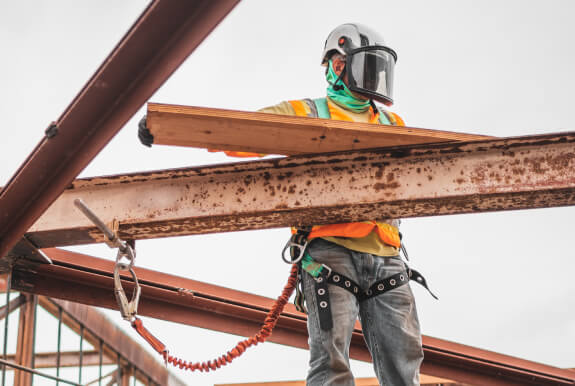Making a New Workplace Culture of Safety Your Company’s Priority
Luckily today’s labor laws combined with union efforts have helped awaken modern companies to the realization that workers are, in fact, valuable assets to be protected at all costs. Yet despite these great advances, many employees have become somewhat complacent when it comes to their own workplace safety. The tables have turned in a way, and now it’s up to savvy employers to find effective ways to create, introduce, and cultivate feasible workplace cultures driven by safety best practices. Here are five steps that can help!
Establish Motivating Goals
It’s easy to find cookie-cutter tips about workplace safety programs, but most fail to address the critical starting factors. For any program to be successful, there must be a strong and clearly defined rationale for introducing it in the first place. .
Before you can build a workplace culture of safety from the ground up, you have to know exactly what your goals are. One obvious and common goal is to mitigate workplace injuries and mishaps. This objective matters for several very clear reasons:
- Injury/mishap mitigation keeps employees safer and healthier (which, from a moral perspective, should be enough reason on its’ own merit);
- Safe, healthy workers are more productive;
- By default, mitigation decreases costly downtime (i.e., lost productivity);
- It reduces the potential for post-incident litigation or higher insurance premiums if a worker is hurt.
As you can see in this case, setting and achieving one goal — such as “mitigating workplace injuries and mishaps” —can lead to several gained benefits. The attainment of these benefits provides the rationale, the incentive to put in the effort needed to establish a successful safety-driven workplace culture!
Obtain Employee Buy-In
Another step that’s often glossed over is the employee buy-in phase. The above benefits provide great reasons why employers should care about workplace safety…but an employer’s motives don’t always overlap with the needs and goals of the workers. For example, most workers care about their personal safety but may not prioritize it as much as they should. Some care about the impact of downtime on production, but others are completely disconnected from that concern. It isn’t a genuine motivation for them.
Yes, managers and supervisors can take a top-down approach and simply dictate conditions, and most employees will more or less fall in line, at least to the minimum degree they’re required to. However, at best, this approach runs the risk of workers not genuinely caring. At worst, workers may come to resent the guidelines and actively seek to subvert them when “no one is looking.”
Management Study Guide pinpoints the issue by noting, “Without the support and involvement of the stakeholders, the program may be subjected to heavy resistance or opposition, a sharp decline in the motivation level and also the overall performance of the employees.”
Here, the stakeholders are also the workers, because we aren’t just talking about implementing a program, but inspiring a workplace culture.
How to Achieve Employee Buy-In
When an organization has to pressure workers into compliance, a program is doomed to struggle. For a safety program to really take hold and stick, it should ideally be employee-centered and employee-driven. The motivation should come from within instead of seeming to be directed from above. To enable the conditions for such buy-in, it is important to have a plan to anticipate pushback and facilitate changes.
A useful strategy for this type of organizational process is offered by Lewin’s Change Management Model, which takes a fairly straightforward three-stage approach:
Stage 1: Unfreezing and Identifying Problem Areas
The first step in Lewin’s model is called Unfreezing. This is the critical time when employee pushback is identified and addressed as workers are asked their input, opinions, and feedback. Given that workers may spend years getting used to “how things have always been done,” the unfreezing process should not be rushed.
Remember, creating a workplace culture takes more time than simply implementing a program. You must install the “need for change” and make workers stakeholders in their own well-being. This is the time to engage with them, identify both broad and specific safety-related problems, goals, and obstacles to reaching those goals.
As you layout and craft the structure for your safety program, employees can help you fine-tune and consider things you may have missed. This is also the time to alleviate doubts, define responsibilities, and adjust your organization’s mission and vision as it pertains to safety, if necessary.
Do all workers have to buy into every idea? No, realistically that may never happen. But ideally, you want them to “own the change” as much as possible so that it becomes ingrained in their thinking and daily actions.
Stage 2: Implementation of Changes
The next step in the Lewin model is Changing. This is where a new workplace safety program and accompanying policies are formally introduced and compliance is expected. The better the Unfreezing stage goes, the smoother the Change process will be.
Still, this is a delicate phase. You’ve spent time and effort persuading employees to try something new. Now they are primed and receptive, but if the implementation doesn’t meet expectations, things can go downhill quickly. Open and honest communication is crucial during this period. Workers must be given the opportunity to provide timely feedback in case there are snags (which, inevitably, there will be. Sometimes a plan sounds great in theory but doesn’t go so well when put into practice). Their concerns must be heard and addressed promptly.
Education, Training & Awareness
Education, training, and awareness are other keys to success here. If new work practices are introduced, all affected employees need to be aware and must fully understand how to perform tasks under the new policy. It is also vital to keep in mind that changes to one task can have a ripple effect impacting others. Those impacts aren’t always anticipated, which can lead to conflict if an affected party was accidentally kept out of the loop. Awareness of new changes can be raised through printed postings, emails, meetings, and training sessions.
Documentation & Accountability
Also, though it is time-consuming, many organizations benefit greatly from documenting and tracking group or individual training. This helps ensure no one is missed. Documentation is also an invaluable compliance tool. When needed, it is useful for holding workers accountable (if, for example, an employee has a mishap and they claim it was due to lack of training or awareness, then a supervisor could rebut that if the worker had previously annotated/initialed a training record or other form of documentation showing that they were, in fact, aware or trained).
Stage 3: Refreezing
The final step of Lewin’s model is Refreezing. At this point, changes have been made but must be solidified through a variety of supportive measures. Let’s take a look at a few of these…
Training, Compliance, Rewards & Accountability
Employers should make a commitment to continual training. Ongoing awareness campaigns and documented education and training sessions ensure everybody is given the same information and held to the same standards. Along with that must come diligent yet caring enforcement, with all workers feeling empowered to demand safety standards be upheld and complied with by everyone.
Compliance involves holding personnel accountable, so long before the Refreezing occurs, employees must understand the consequences of failing to follow standards. By contrast, setting up a rewards initiative can help inspire workers to follow the agreed-upon game plan!
Safe Reporting
Along with compliance must come a safe reporting system where employees can speak up without fear of reprisal. Anonymous reporting systems are one option to accomplish this, however, they are not always effective at maintaining the reporter’s anonymity (especially in a small work center). Full transparency and frank discussions are sometimes better, depending on how the organization is laid out. Also, simply having upfront conversations in advance, where expectations and consequences are clearly spelled out, can make a big difference.
Setting the Example
Another element that plays a major role in the success of a new safety-driven workplace culture is management modeling. If there is a situation of managers playing a game of “do as I say, not as I do,” then workers will rightfully cry foul at the hypocrisy. From C-suite executives to frontline supervisors, everyone has to be on board and set the example for the team to follow.
Continual Growth
As you can see, the Refreezing process is a never-ending phase. However, just as important as Refreezing is the concept of continual growth. Work centers cannot expect to introduce a change then lock it into place forever because no environment is completely static.
We live and work in an ever-changing and unpredictable world. Organizations — and their employees at all levels of the hierarchy — must stay flexible and open to adopting change that keeps up with the times. Only with continual employee buy-in can a safety-driven workplace culture achieve its full potential.




